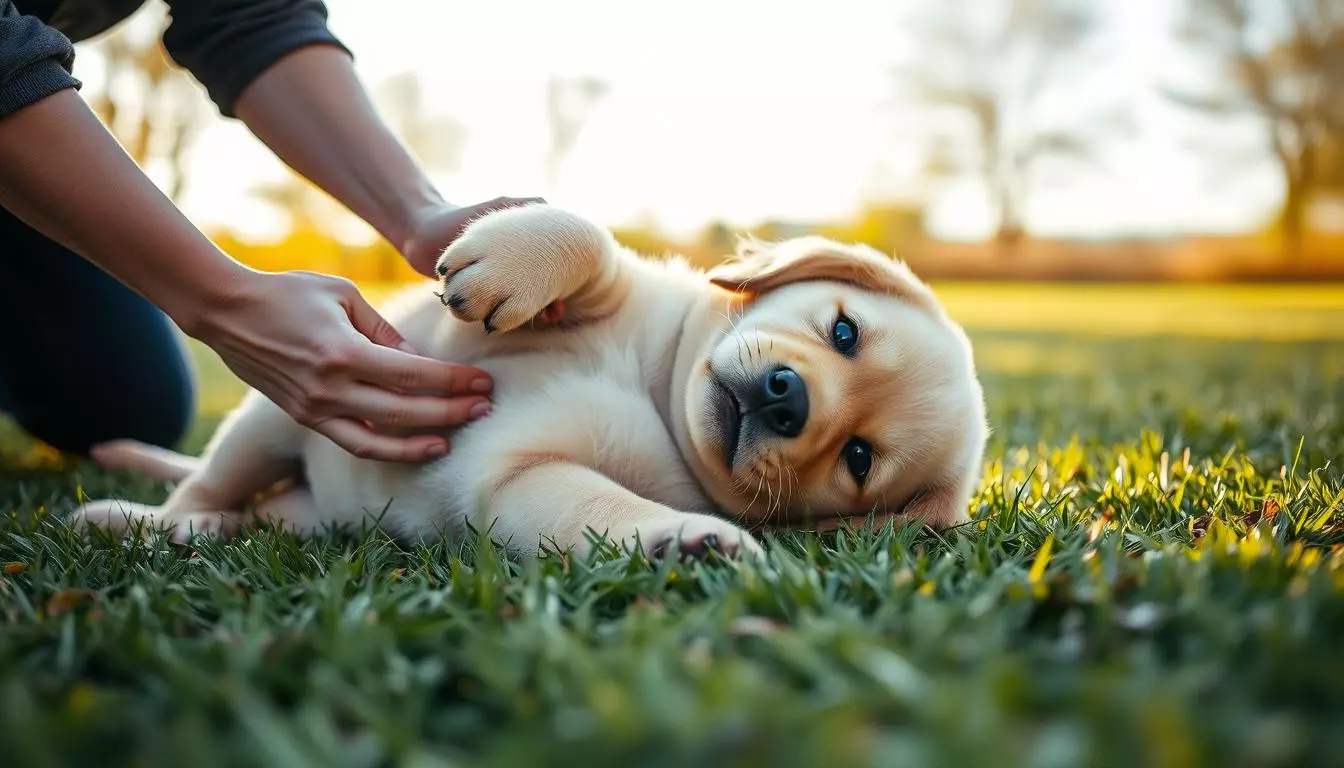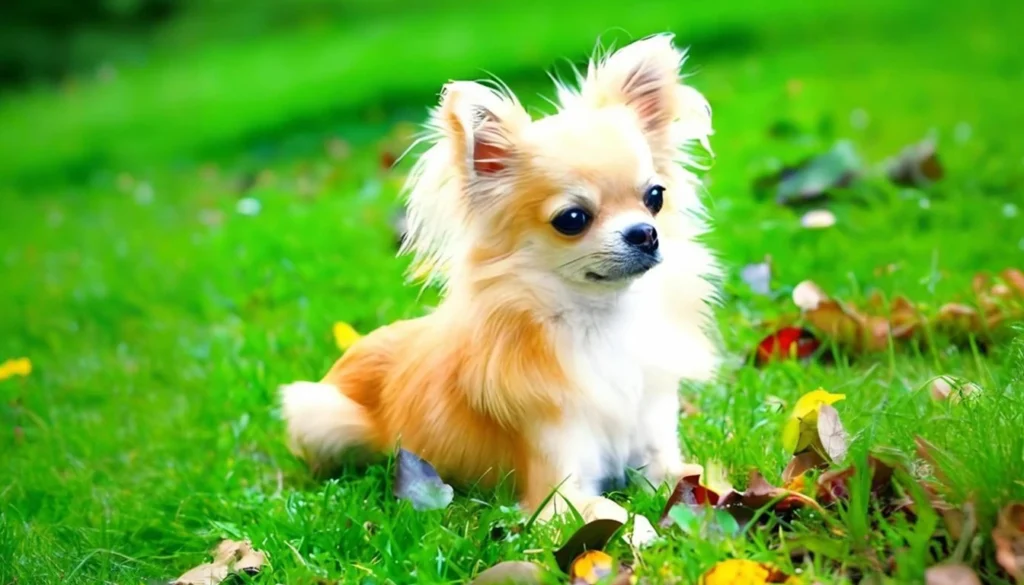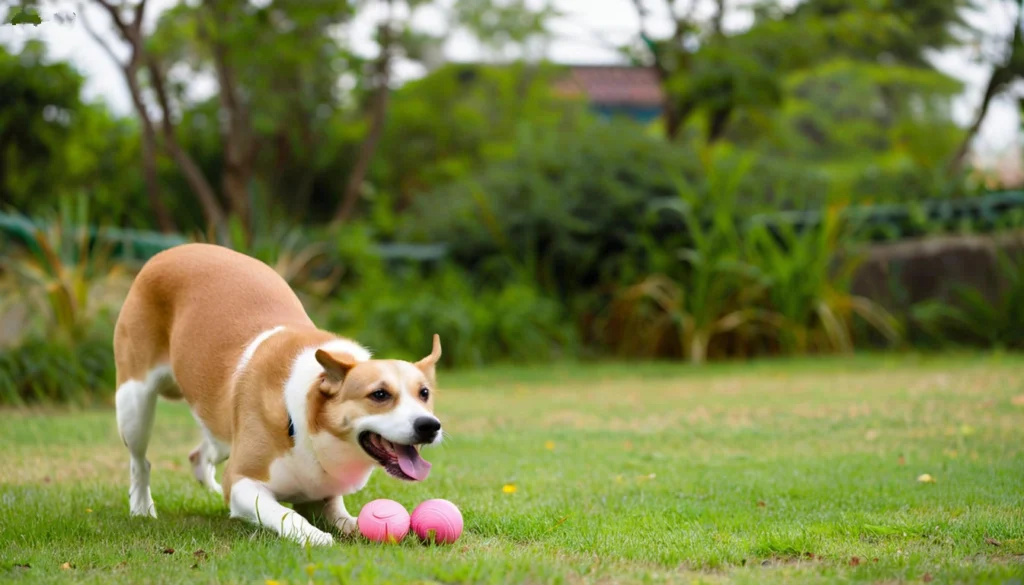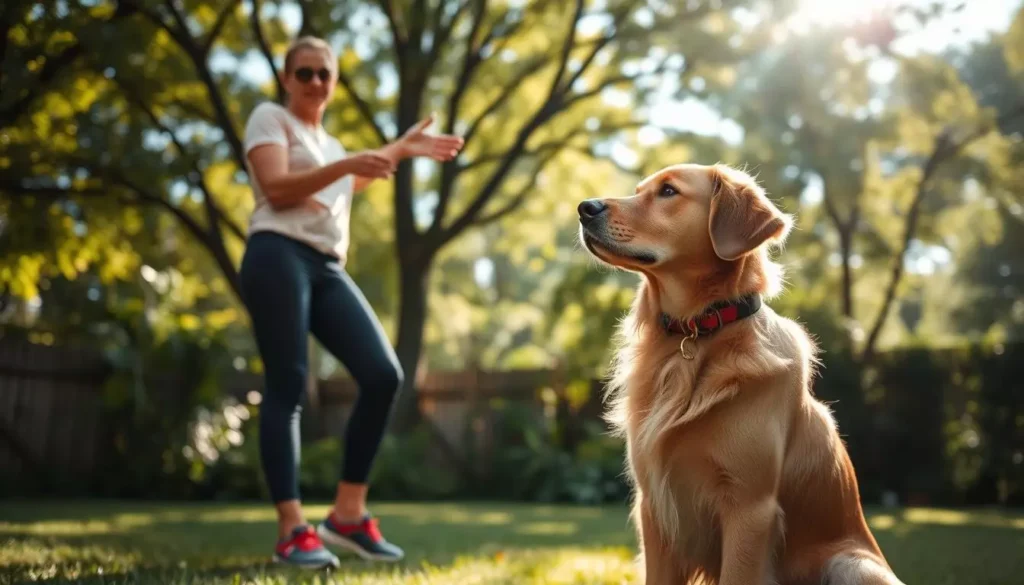Every dog owner wants to teach their pet cool tricks. These tricks show off their dog's smarts and bring them closer. Teaching your dog to roll over is more than just a fun trick. It's about making a special bond with your dog through fun training.
When my rescue Labrador, Max, first rolled over, it was a big moment. His tail wagged, and he was so happy. This trick makes training sessions special for both of you.
Roll over is more than a cute trick. It keeps your dog's mind sharp and body active. With time and effort, your dog will learn this fun command quickly.
Key Takeaways
- Roll over is an engaging trick that strengthens dog-owner bonds
- Mental and physical stimulation are key benefits of training
- Patience and positive reinforcement are crucial for success
- Every dog can learn at their own pace
- Training builds confidence in both dog and owner
Understanding the Basics of Roll Over Training
Dog obedience training is a great way to bond with your pet and teach them cool tricks. Roll over is a classic trick that can make learning fun for your dog and strengthen your bond.
Before starting roll over training, it's important to know the basics. Successful dog training needs patience, consistency, and understanding your dog's learning style.
Prerequisites for Teaching Roll Over
Getting ready for roll over training involves a few steps:
- Make sure your dog knows the down command
- Choose a quiet, comfy training spot
- Have lots of small, tasty treats ready
- Keep a positive, relaxed attitude
Benefits of Teaching This Trick
Roll over is more than just a fun trick. It has many benefits for you and your dog:
- It improves communication between dog and owner
- It builds trust and cooperation
- It provides mental stimulation
- It makes dog obedience training more effective
Mental Stimulation and Physical Exercise
Roll over is not just a cute trick—it's a full training exercise. It challenges your dog's mind and gives them gentle physical movement. Dogs who train regularly are more balanced, confident, and well-behaved.
By knowing these basics, you're ready to start an exciting training journey with your dog.
Essential Equipment and Training Environment
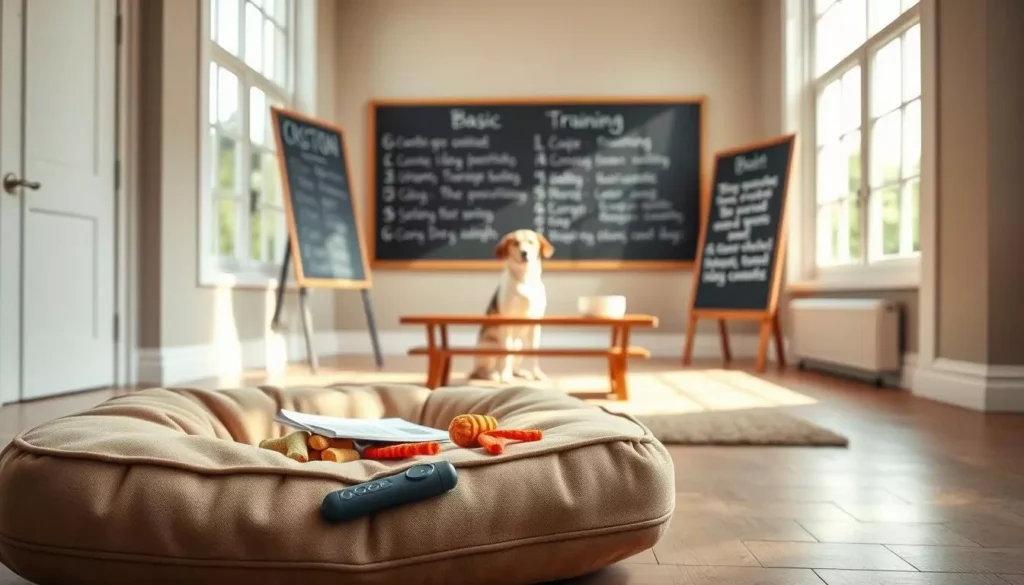
Learning to train a dog to roll over starts with the right environment. Choose a quiet, comfy spot with few distractions. Make sure it has a soft surface for your dog to practice on.
The perfect training area should have a few key things:
- A quiet room with minimal background noise
- Soft flooring like a carpet or thick rug
- Adequate space for your dog to move freely
- Good lighting and comfortable temperature
For reward-based training, the right treats are essential. Pick small, soft treats that your dog can eat fast. This keeps them focused during training.
| Treat Type | Benefits | Size Recommendation |
|---|---|---|
| Soft Training Treats | Quick consumption | Pea-sized pieces |
| Lean Meat Bits | High protein, low fat | Small cubes |
| Commercial Training Treats | Specifically designed | Bite-sized |
Using a clicker can also help your training. It marks good behavior clearly. Make sure you have all your gear ready before you start training your dog to roll over.
The Importance of Starting with Basic Commands
Before teaching your dog to roll over, it's key to build a strong foundation in basic obedience. Your dog needs to learn simple commands first. These commands are the base for more complex tricks.
Training your dog is all about adding skills step by step. Basic commands are like the first bricks in a building. Your dog must get these right before tackling harder tricks like rolling over.
Mastering the "Sit" Command First
The "sit" command is a must for starting dog training. It shows your dog can focus and listen. Here's how to teach it:
- Hold a treat close to your dog's nose
- Slowly move the treat above and slightly behind their head
- As their head tilts back, their bottom will naturally lower
- Say "sit" and immediately reward when they comply
Perfecting the "Down" Position
Once your dog knows "sit," it's time for "down." This is crucial for the roll over trick. It's where the rolling starts.
| Command | Training Difficulty | Importance for Roll Over |
|---|---|---|
| Sit | Easy | Initial positioning |
| Down | Moderate | Essential starting position |
| Roll Over | Advanced | Requires previous commands |
Keep practicing these basic commands. Patience and positive reinforcement are key. They help your dog learn the skills for more advanced tricks like rolling over.
How to Train Your Dog to Roll Over
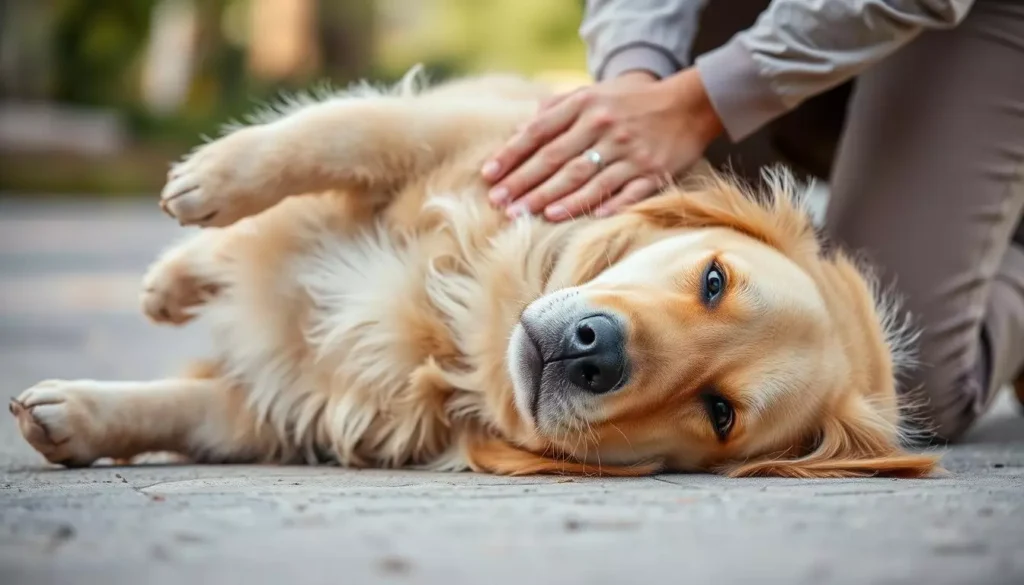
Teaching your dog to roll over is a fun and rewarding process. It takes patience and regular practice. I'll show you the key steps to help your dog learn this cool trick.
First, make sure your dog is comfortable lying down. This is a basic step for successful trick training.
- Begin with your dog in a relaxed down position
- Hold a tasty treat close to their nose
- Slowly move the treat from their nose towards their shoulder
- Encourage them to follow the treat with their head
- Guide them to roll onto their side
- Continue moving the treat to complete the full roll
For successful training, make it a positive experience. Use treats that really excite your dog. Soft, small treats work best during training sessions.
"Patience is the secret ingredient in dog training. Every small progress is a victory!" - Professional Dog Trainer
Keep training sessions short and fun. Each try brings your dog closer to mastering the roll over. Always praise and reward them, making learning fun for both of you.
| Training Stage | Duration | Key Focus |
|---|---|---|
| Initial Introduction | 5-10 minutes | Treat Luring |
| Partial Roll Practice | 10-15 minutes | Body Movement |
| Full Roll Mastery | 15-20 minutes | Complete Command |
With regular practice and positive feedback, your dog will learn to roll over in no time!
Using Positive Reinforcement Techniques
Teaching a dog to roll over needs a positive and fun learning space. It's all about making the training enjoyable for both you and your dog.
Positive reinforcement turns training into a fun bonding time. It focuses on encouragement and rewards, helping your dog learn tricks better.
Choosing the Right Treats
Choosing the right treats is key when teaching your dog to roll over. Look for small, soft treats that your dog loves. The best rewards are:
- Tiny pieces of cooked chicken
- Small cheese cubes
- Commercial training treats
- Soft, easily consumed snacks
Timing Your Rewards
Timing your rewards is crucial for success. Give treats right after your dog does what you want. This reinforces the behavior.
| Reward Timing | Impact on Training |
|---|---|
| Immediate Reward | Strongest Learning Connection |
| Delayed Reward | Weak or Confusing Signal |
Verbal Praise and Physical Affection
Verbal praise and gentle petting are also important. Use a happy, high-pitched voice and show excitement when your dog rolls over.
Consistency and patience are key in positive dog training. Each session should be a positive, enjoyable time that strengthens your bond.
Common Challenges and Troubleshooting
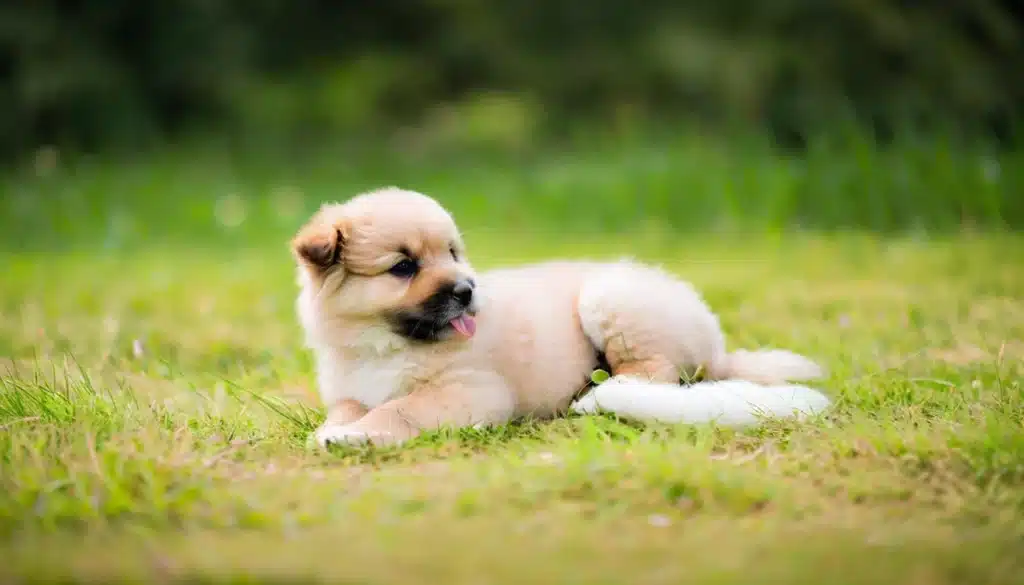
Teaching your dog to roll over can be tough. Some dogs might not like it because it hurts, they're not interested, or they're naturally hesitant. Knowing these issues is key to training your dog well.
Dogs with certain body types might find it hard to roll over. Some breeds have bones or flexibility issues that make training painful. You'll need to adjust your training methods and be gentle.
- Identify your dog's physical limitations
- Use softer training surfaces like carpet or yoga mats
- Break down the roll over command into smaller steps
- Watch for signs of discomfort or resistance
Some dogs might not like showing their belly, making the command hard. Patience and positive reinforcement help overcome these mental hurdles.
If your dog keeps saying no, try something different. Not every dog will get it right away. Change your training, use treats, and keep things positive.
Remember, successful training is about understanding your dog's unique personality and learning style.
Some dogs need more time and creative ways to learn. Always think about what's best for your dog while teaching them to roll over.
Advanced Training Tips and Modifications
Once you've got the basic roll over trick down, it's time to take your clicker training to the next level. The aim is to make your interactions with your dog smooth and responsive. This is key when teaching your dog to roll over.
As your dog gets better, you'll need to use fewer treats and hand signals. This step is crucial for a deeper connection with your pet.
Reducing Hand Signals
Getting rid of hand signals takes time and practice. Start by making your hand movements smaller but keep rewarding your dog the same way. Your dog will learn to connect the action with the command, not just the hand signal.
- Begin with subtle hand movements
- Gradually decrease hand signal size
- Reward consistently for correct behavior
Adding Verbal Cues
Adding verbal commands makes training more flexible. Pick a clear, consistent word like "roll" or "spin" to go with the action.
| Training Stage | Hand Signal | Verbal Cue | Reward |
|---|---|---|---|
| Initial Training | Large, obvious | No verbal cue | Treat after every attempt |
| Intermediate | Smaller gesture | Soft verbal prompt | Intermittent treats |
| Advanced | Minimal movement | Clear verbal command | Praise-based rewards |
Pro tip: Keep training sessions short and fun. This will keep your dog eager to learn.
Safety Considerations During Training
When teaching your dog to roll over, safety is key. Dog training needs careful thought about your pet's limits and comfort. Not every dog will find this trick easy, especially those with physical issues or older dogs.
Here are important safety tips for dog training:
- Choose a soft, padded surface like a carpet or exercise mat
- Keep training sessions short (5-10 minutes)
- Watch for signs of discomfort or fatigue
- Stop immediately if your dog shows stress or pain
Physical limitations matter more than completing the trick. Some dogs might find it hard to roll over because of their breed, age, or past injuries. Always talk to your vet if you're worried about your dog's ability to do this command.
Watch your dog's body language during training. If they show stiff movements, whimpering, or don't want to keep going, it might mean they're in pain. A good trainer knows that respecting your dog's limits is more important than just the trick.
Remember, successful dog training is about trust and enjoying the journey together. Keeping things safe makes sure both you and your dog have a good time.
Maintaining and Reinforcing the Behavior
Teaching your dog to roll over is just the start. Keeping up with this trick needs a solid plan and dedication. It's important to keep your dog interested and eager to learn.
Having a regular practice routine is essential. It helps your dog stay excited about the roll over command. I suggest setting up a clear plan for teaching and keeping up the trick.
Creating an Effective Practice Schedule
- Practice 3-5 times weekly for 5-10 minutes
- Choose consistent times like after morning walks
- Keep training sessions short and enjoyable
- Rotate practice locations to maintain interest
Long-Term Success Strategies
To keep your dog's roll over skill sharp, you need to keep things interesting. Variety is crucial in dog training techniques. Try different things like:
- Introducing slight variations in the command
- Using different reward types
- Practicing in diverse environments
- Gradually reducing treat frequency
"Consistency and patience transform good training into great results." - Professional Dog Trainer
Don't forget about your dog's physical limits. Some dogs might find rolling over hard. Always check if your pet is okay and adjust the training if needed.
Training Sessions Duration and Frequency
Teaching a dog to roll over needs patience and a smart training plan. Knowing the right session length is key for your dog to learn well.
Keep training sessions short and fun. Sessions of 5-10 minutes are best to keep your dog focused and avoid boredom. Puppies and young dogs need even shorter sessions, while adult dogs can handle a bit more time.
- Puppies (3-6 months): 3-5 minute sessions
- Adult dogs: 5-10 minute sessions
- Senior dogs: 5-7 minute sessions
How often you train is also important. Try for 2-3 short sessions a day, spread out. Being consistent helps your dog learn to roll over.
"Short, frequent training moments create lasting learning experiences for dogs." - Professional Dog Trainer
Look for signs your dog is tired or bored. If they seem off or uninterested, stop the session. Always end on a positive note with praise and a treat.
| Dog Age | Session Length | Daily Frequency |
|---|---|---|
| Puppy | 3-5 minutes | 2-3 times |
| Adult Dog | 5-10 minutes | 2-3 times |
| Senior Dog | 5-7 minutes | 1-2 times |
Remember, every dog learns differently. Adapt your training approach based on your dog's individual personality and learning pace.
Conclusion
Learning to train your dog to roll over is a fun journey. It makes your bond stronger. Using positive training methods makes it enjoyable for both of you. The main thing is to be patient, consistent, and understand how your dog learns.
Every dog learns at their own speed. Some might learn fast, while others need more time. The most important thing is to be supportive and encouraging during training. Celebrate small wins and keep it fun.
Teaching tricks is more than just commands. It's about building trust and respect with your dog. The skills you learn will make your relationship stronger. You'll create lasting memories and a deeper connection.
Approach dog training with excitement and love. Your hard work will help your dog learn new things. It also keeps their mind and body active. Stay positive, be patient, and enjoy every moment with your furry friend.

